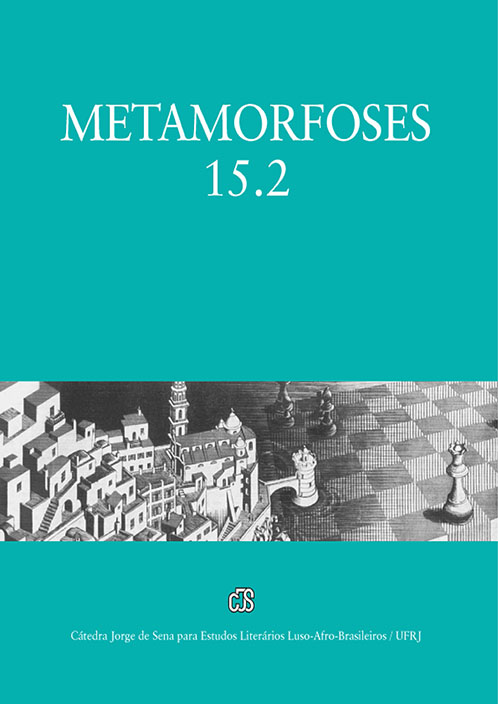Conception and collapse of the image of the father in the book ‘When my father met the ET it was a hot day’, by Lourenço Mutarelli
DOI:
https://doi.org/10.35520/metamorfoses.2018.v15n2a19532Keywords:
Image. Memory. Comics. Father.Abstract
The production of Lourenço Mutarelli is plural, which goes far beyond what configures the language of comics. It is possible to verify the paternal figure as very significant in his work, especially in one of his more recent works, the book When my father met the ET it was a hot day (2011). Among the configurations proposed in his work, we find the paternal figure intertwined with the words and, especially, with the images of the book. In the illustrations, an “imperfect” repetition of the paternal figure proclaims a desire for remembrance and fixation of its materiality, that is, the artist seeks to preserve and isolate this image from the place and from the time of its “real” apparition (BERGER, 1982). In this procedure, Mutarelli’s work dialogues with the specificity of the image as memory and receptacle of the longing for permanence and denial of death. Based on these assumptions, we intend to verify how the construction of this character takes place in the development of the work and as it evokes the essential process of temporality of the image, which only has reality insofar as it refers to knowledge and values previously acquired, that is, recalled (FRANCASTEL, 1998).
Downloads
References
AGAMBEN, Giorgio. “O rosto”. N: In: Mezzi senza fine. Note sulla politica. Tradução Murilo Duarte Costa Corrêa. Bollati Boringhieri: Torino, 1996, p. 74-80.
AGAMBEN, Giorgio, 1942- Profanações. Tradução e apresentação de Selvino José Assmann. - São Paulo: Boitempo, 2007.
BERGER, John. Modos de ver. São Paulo: Martins Fontes, 1982.
BIOGRAPHY. William Burroughs. Disponível em: < https://www.biography.com>. Acesso em: Jul. 2018.
DIDI-HUBERMAN, Georges. A imagem sobrevivente: história da arte e tempo dos fantasmas segundo Aby Warburg. trad. Vera Ribeiro. Rio de Janeiro: Contraponto, 2013.
FRANCASTEL, Pierre. A imagem, a visão e a imaginação. Trad. Fernando Caetano. Lisboa: Edições 70, 1998.
GAGNEBIN, Jeanne Marie. Lembrar escrever esquecer. São Paulo: Ed. 34, 2006.
LINDEN, Sophie Van der. Para ler o livro ilustrado. São Paulo: Cosac Naify, 2011.
MCGUIRE, Richard. Aqui. Tradução Érico Assis. 1ª edição. São Paulo: Quadrinhos na Cia, 2017.
MUTARELLI, Lourenço. Quando meu pai se encontrou com o ET fazia um dia quente. São Paulo: Companhia das Letras, 2011.
________. A caixa de areia. São Paulo: Companhia das Letras, 2005.
________. Diomédes: A trilogia do acidente, edição completa. São Paulo: Companhia das letras, 2012.
________. O cheiro do ralo. São Paulo: Companhia das letras, 2002.
MUTARELLI, Lourenço [et al.]. O grifo de Abdera. São Paulo: Companhia das Letras, 2015.
SAMAIN, Etienne. Como pensam as imagens. In. SAMAIN, Etienne (Org.) Como pensam as imagens. Campinas, SP: Editora Unicamp, 2012.
SPIEGELMAN, Art. Breakdowns: retrato do artista quando jovem %@. Tradução Vanessa Bárbara. São Paulo: Companhia das letras, 2009.
RAJEWSKY, Irina O. Intermidialidade, intertextualidade e “remediação”. IN: DINIZ, Thaïs Flores Nogueira. (Org.) Intermidialidade e estudos Interartes: desafios da arte contemporânea. Belo Horizonte: Editora UFMG, 2012.
RICOEUR, Paul. Memória, história e esquecimento. Conferência foi escrita e proferida em inglês por Paul Ricoeur a 8 de Março de 2003 em Budapeste sob o título “Memory, history, oblivion” no âmbito de uma conferência internacional intitulada “Haunting Memories? History in Europe after Authoritarianism”. Disponível em: <http://www.uc.pt/fluc/uidief/textos_ricoeur/memoria_historia>. Acesso em: Jan 2018.
TRIGO, Luciano. Lourenço Mutarelli: “Meu pai é uma figura central na minha vida”. Portal G1. Publicado em 15/11/2015. Disponível em: <http://g1.globo.com/pop-arte/blog/maquina-de-escrever/post/lourenco-mutarelli-meu-pai-e-uma-figura-central-na-minha-vida.html>. Acesso em: Mai 2018.
Downloads
Published
Issue
Section
License
Autores que publicam nesta revista concordam com os seguintes termos:
- Autores mantêm os direitos autorais e concedem à revista o direito de primeira publicação, com o trabalho simultaneamente licenciado sob a Licença Creative Commons Attribution que permite o compartilhamento do trabalho com reconhecimento da autoria e publicação inicial nesta revista.
- Autores têm autorização para assumir contratos adicionais separadamente, para distribuição não-exclusiva da versão do trabalho publicada nesta revista (ex.: publicar em repositório institucional ou como capítulo de livro), com reconhecimento de autoria e publicação inicial nesta revista.
- Autores têm permissão e são estimulados a publicar e distribuir seu trabalho online (ex.: em repositórios institucionais ou na sua página pessoal) a qualquer ponto antes ou durante o processo editorial, já que isso pode gerar alterações produtivas, bem como aumentar o impacto e a citação do trabalho publicado (Veja O Efeito do Acesso Livre).

